“KM doesn’t have to be hard or complicated, and it doesn’t have to take a long time.”
Value Creation from Knowledge
This concept is understood by high performing knowledge enabled organizations who derive the following value:
1. They leverage their knowledge in ongoing operations to immediately improve performance
2. They improve their ability to learn from past challenges and successes in strategic decision making and customer delivery
3. They create long term value from knowledge, experience, and insight held by their workforce
4. They create long term value from knowledge, experience, and insight gained from customers
Our Perspective on Knowledge
We view knowledge as comprising “all the information” in your organization and “all the experience and insight” in your organization. By leveraging and focusing this knowledge, in context, not only will you be able to improve your individual, team, and organmzation performance, but also you will be able to deliver value to your employees, your clients or customers, and your organization. This will improve your ability to develop the best solutions and make the best decisions.
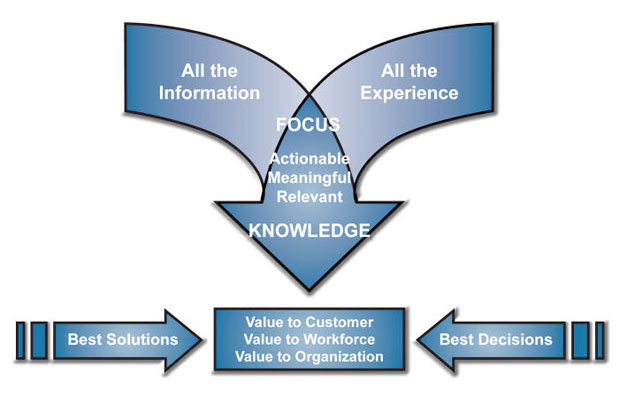
KNOWLEDGE AT THE POINT OF EXECUTION®
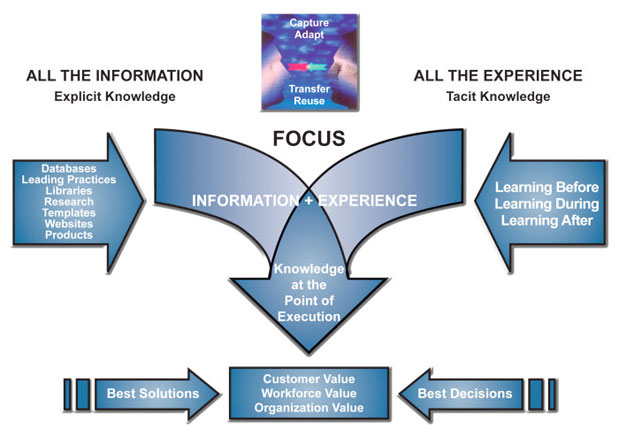
The concept of Knowledge at the Point of Execution® integrates the ability to “connect, collect, and collaborate” with the discipline and consistent behavior to learn before, to learn during, and to learn after work is done to provide your organization with the ability to access in real time not only codified knowledge (effective practices, relevant documents, templates), but also the most current tacit knowledge (experience and insight) that is the “know how” and “know why” of your business and operations.
KM Framework
Integrating “Fast” Learning Processes, Communities of Practice, Knowledge Repositories (Assets), and Enabling Technology
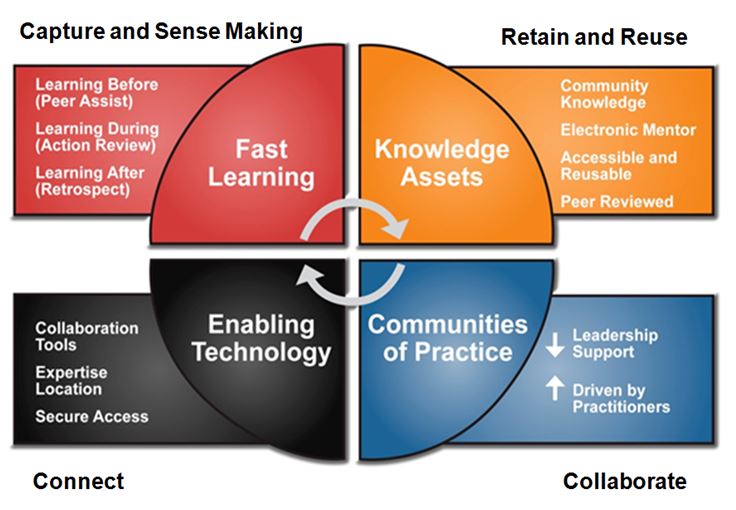
1. “Fast” Learning Processes: The learning processes enable you to capture knowledge and make sense out of it before, during, and after you execute or deliver. These Fast Learning processes, part of an integrated and consistent behavior for learning lessons, contribute the content for the knowledge assets (knowledge repositories with knowledge content) which store for easy access and reuse your information and experience.
2. Communities of Practice (COP): A community of practice is about collaborative behavior and effective knowledge transfer. Some common understandings about CoPs are a group of individuals:
- who voluntarily collaborate for a shared purpose
- whose collective action significantly impacts individual performance and professional development
- whose ongoing interactions provides a sense of identity and a mechanism for mentoring and personal development
- whose interaction is expected to last while it serves their common purpose and enhances their relationships
Knowledge from your CoPs is harvested and characterized for reuse in your knowledge repositories so that it can be re-used and adapted by fellow practitioners within that CoP or across your organization. Key to the success of communities is the support of the leadership in terms of time, investment, and resources to participate, maintain, and most importantly, sustain the communities.
3. Knowledge (Assets) Repositories: A simple way to describe a knowledge asset might be to call it a repository of knowledge or more accurately a “virtual mentor.” But it is really more multidimensional and dynamic than that when planned, constructed and applied effectively. Your knowledge repository may contain processes and methodologies, key insights, learnings and advice in the form of guidelines, checklists, effective practices and “first person stories” in the form of short vignettes that clearly highlight critical learnings, insight or experience; the business “context” in which the learning occurred and a link to the originator of the knowledge.
4. Enabling Technology: Enabling technology is the IT infrastructure and applications that enable “connection, collection and collaboration” from any location. This provides the means for accessing the knowledge and communicating effectively and efficiently across your organization, with your clients or customers, and with members of your communities and others outside the communities.
The path from concept, to strategy, to implementing practice will guide your development into a high performing and knowledge enabled organization reflecting the attributes below. You can evolve into a learning organization, one that not only shares knowledge as a matter of course, but also captures and “learns lessons” as you perform, and effectively transferring those lessons across the boundaries of your organization.
Organizations successful not only in making knowledge management part of their business and operational processes and work flows, but also in sustaining their investment in knowledge management, share common attributes in the areas of people/culture, process, enbaling technology, and KM strcuture and governance. These attributes should be guiding principles for KM evolution and sustainment in your organzation. The figure below reflects these attributes:
Knowledge Enabled Organizations
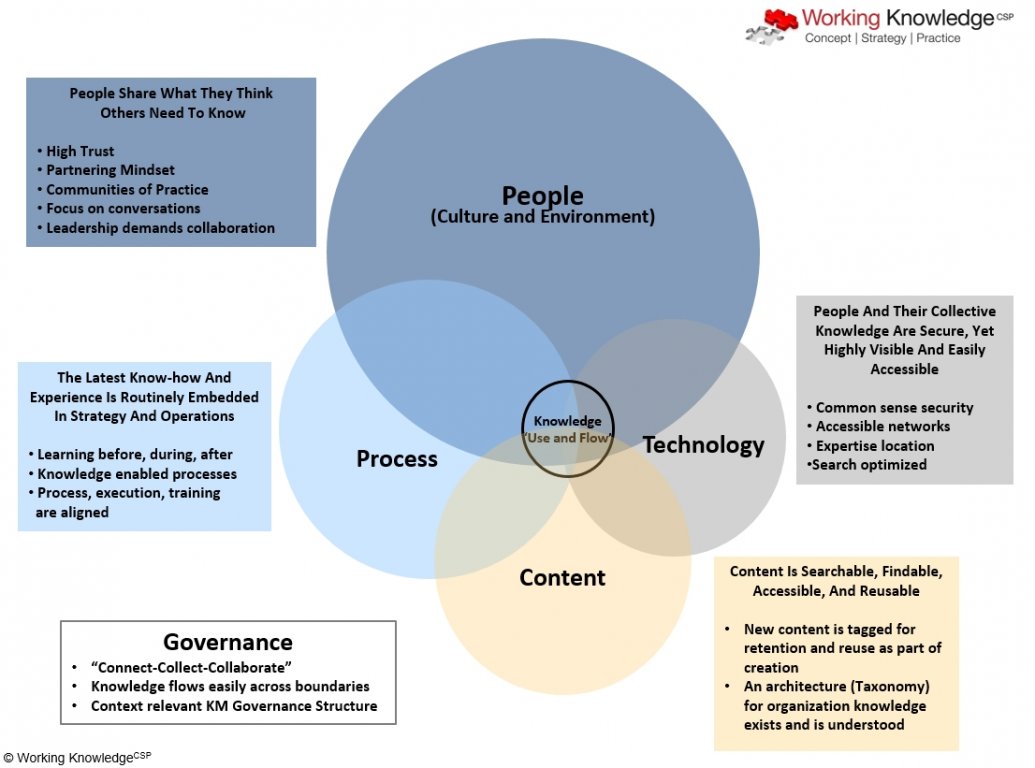
People: These organizations promote and sustain an environment where people share what they think others need to know because there is high trust and a partnering mindset. People see value in capturing knowledge and the time it takes to do this is viewed not as an extra task but as a part of the way work is accomplished. Collaboration exists and knowledge easily moves across boundaries. Leadership demands collaboration and measures performance by it.
Process: Knowledge is used to make changes in the future direction of the organization. Knowledge is captured routinely as part of the operating processes of the organization and these improvements in process also result in changes in the corresponding training associated with the processes.
Technology: Knowledge needed is secure, searchable, findable, accessible, and downloadable when it’s needed to satisfy the knowledge seeker’s need. Enabling technology supports the ability for members of an organization to “connect with knowledge sources, be that a repository or a person, collect relevant knowledge, and collaborate across the organization, in effect, moving knowledge across the organization. Enabling technology by itself is not KM, but it is a pathway by which the flow of knowledge acros the boundaries of your organzation is improved and leveraged.
Content: Content has a lifecycle, from creation to permanent storage or deletion. Content can be in physical form, including paper, or digital form, such as images, video, audio and multimedia as well as text. Knowledge, when made explicit, is part of the content store.
Structure and Governance: Sustaining your KM investment and desired KM outcomes is facilitated by a KM structure and governance model that is a fit for and supports your business and operational environment, your organizational culture and workforce dynamics, and your organization command and the control structure.
Operationalizing Learning©
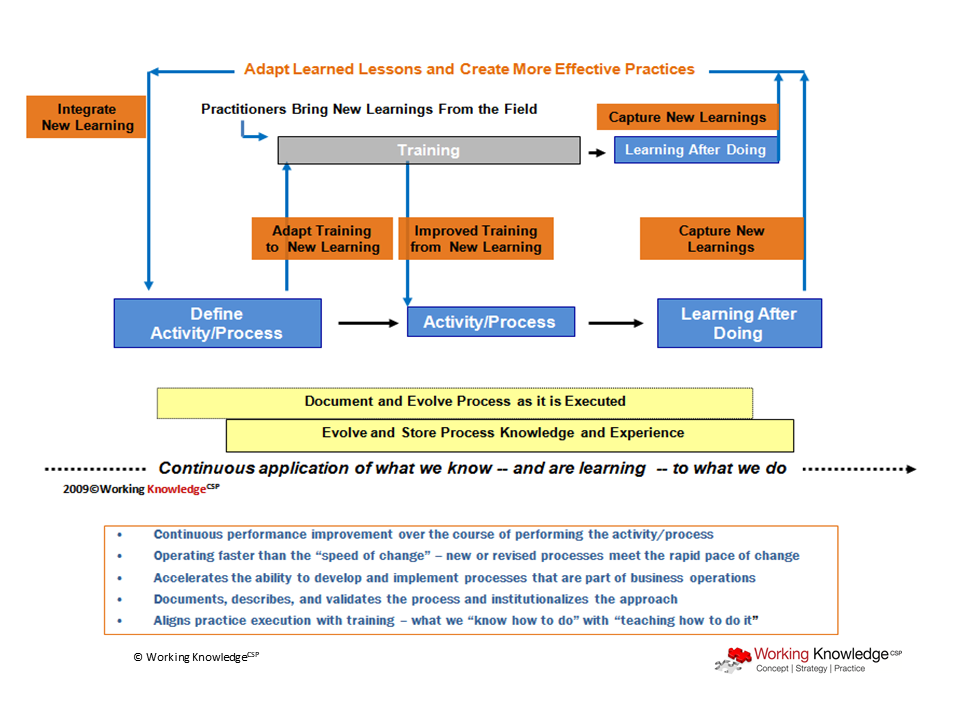
Operationalizing Learning© is a highly effective knowledge management practice developed and implemented by Working KnowledgeCSP. Working KnowledgeCSP will work with you to identify the most critical and relevant processes in your organization. Using Critical Knowledge Capture (CNC), a systematic and disciplined process for capturing operational (practitioner) knowledge and then analyzing the flow of work within the process, we will then work with you to map the process ensuring that it reflect inputs, outputs, and the influence and relationships of other people, processes, and factors that may have an impact on the process outcome and outputs.
Process analysis and mapping helps you to visualize and communicate the foundational building blocks of your organization showing: (1) how and where value is created, (2) where the organization’s resources are consumed, and (3) which are your primary connections with customers, constituents and other organizations. Unfortunately, business processes in many organizations are undefined, not representative of how work actually gets done, and inefficient. Organizations that are unable to consistently learn before, during, and after process execution deliver marginalized performance and poor quality. If you can’t see it, it is harder to improve it through the reinvestment of learning associated with the process.
High performing, knowledge enabled organizations (1) align process, execution of the process, and training on the process, (2) through proven techniques for quickly capturing the knowledge about the process and then (3) integrate and align this new learning with the training necessary to execute the process as it is actually being performed.
This ensures that the most current “know how” and “know why” of process execution is always part of
the process training so new staff enter an operational environment aligned with and knowledgeable about the way work actually gets done. This is known as ‘Operationalizing Learning.’
Specifically, we work with you to create alignment between codified process, the execution of the process, and the training about the process, to ensure that:
- Changes in operational field knowledge, based on new learnings elicited from those who have the responsibility for delivering the work, is reinvested in the process to ensure that the codified process always reflects that most current practitioner knowledge and practices,
- The most current operational (practitioner) knowledge is captured and then made immediately available for reinvestment to make corresponding and concurrent changes in the training supporting the process.
- What is taught in the “schoolhouse” reflects the way that work is actually being accomplished so that graduates of the training are able to operationalize that learning and deliver the expected outcomes and output immediately.

